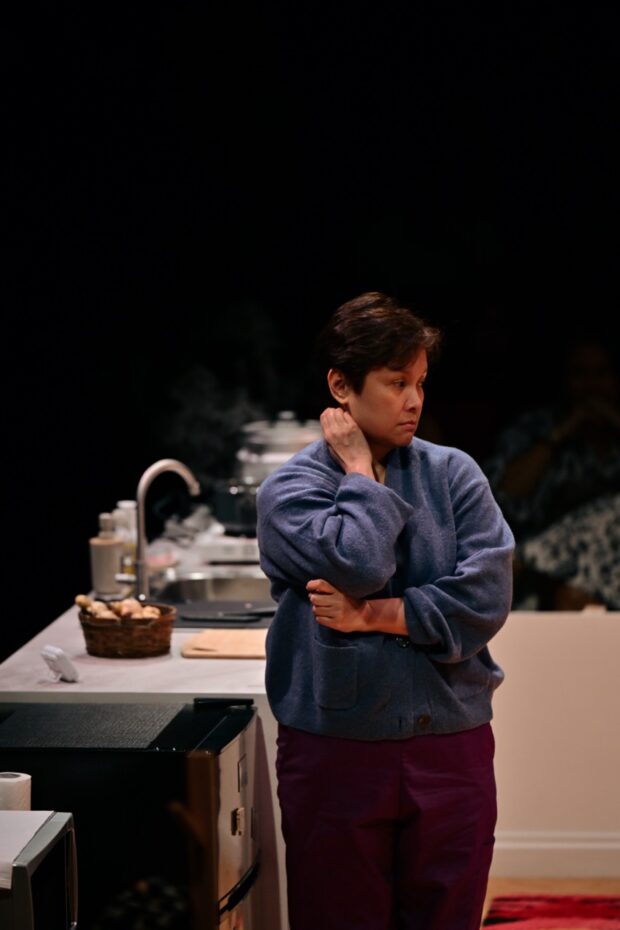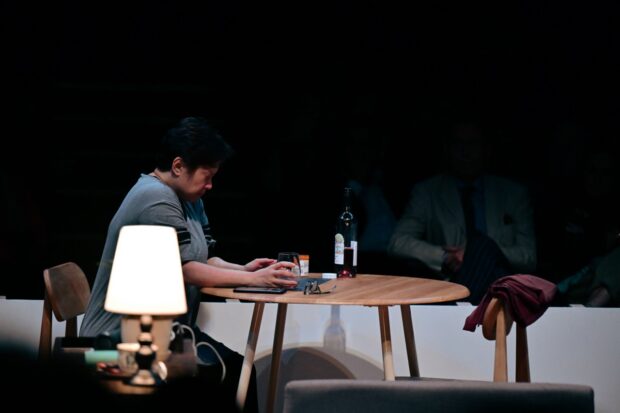Amid the thriving theater scene of late, one production is bent on shaking things up.
As much as this play had little to no words (save for the radio program from which the play takes its title), so too did we have little word on what to expect out of “Request sa Radyo,” the first Filipino adaptation of Franz Xaver Kroetz’s “Wunschkonzert” (“Request Program”). Leading up to its premiere, we’ve only heard of its premise and the talents that have come together to put the show together.
This has effectively built intrigue and curiosity about the show, especially on how two internationally acclaimed actresses, Lea Salonga and Dolly De Leon, would take on this non-speaking role. If you think about it, no one else could possibly make as much impact and buzz for a piece of this kind right now, and the choice of both Salonga and De Leon complement the themes contained within this play.
The piece, the choice of actors, and even the production design have been set to make this theatrical, almost performance art piece a jarring experience. From the moment you buy your ticket, you’re already setting up for the experience (the steep price you could take for a metaphor, too, if you will); and as you enter the theater-within-a-theater (producer and designer Clint Ramos had built their own black box theater on the stage of the Samsung Performing Arts Theater), we start to get a glimpse into the layers of meaning and messaging, neatly interspersed throughout.
READ: Lea Salonga and Dolly De Leon on ‘Request sa Radyo’ and lessons learned
The black box, formed like a cluster of cargo crates, represents the world of the play’s main character, Ms. Reyes, an older Filipina working overseas in the medical field. It hints at the irony: While our country is one of the top exporters of care, many of our care workers lack the very care they provide. This crafted theater space also represents her world: the smallness and the feeling of being so closed in and suffocated by her circumstances.
 Lea Salonga as Ms. Reyes. She alternates with Dolly De Leon. Photo by Sandro Paredes/Request sa Radyo
Lea Salonga as Ms. Reyes. She alternates with Dolly De Leon. Photo by Sandro Paredes/Request sa Radyo
As we enter the black box (making our way through the dim pathways of what normally is backstage), we’re suddenly greeted by warm light. The normalcy, especially upon seeing the tidy little apartment studio at the center, is once again jarring, and then lulls us into a pretense of calm.
The play begins, and we see the woman (in the preview we have seen, portrayed by Salonga), visibly weary and fatigued after what I could imagine was a long day at work, enter her apartment. Thus begins the routine: carefully taking off and setting aside her outside clothes, putting away the small amount of groceries she came home with, preparing dinner. All done with an absurd neatness and meticulousness, we watch Salonga quite literally do chores. Properly washing and cooking rice, washing dishes (with a working sink!), setting the table, vigorously wiping surfaces clean.
We see her evening play out, slow, almost uncomfortably quiet. Introverts like me may have no problem with spending time alone, and may think, at least at the start of the play, that this is all very normal, but the longer you sit and watch her closely, the more unnerving it becomes. Especially if you imagine this very same routine repeated for days on end. Watching her routine makes me think: “Would I do that? Would I do it that way?” As minutes pass and we watch her browse through her mail, or begin doom-scrolling on her phone, or watch the steam rising from her rice cooker, the audience is urged to examine themselves, too.
When she puts on the radio, the stifling silence is lifted partially, if only because the radio is too faint for the entire theater to hear. But perhaps that is the point; we’re invisible intruders into this woman’s life, voyeurs who aren’t supposed to see these private moments, and yet we do.
It feels almost wrong to peer into someone’s privacy like this, where they are more vulnerable and most real. It makes you uncomfortable at some point.
But we continue watching her go through her routine, eating a small and simple dinner (which she barely even finishes) as she listens to the radio program playing various OPM hits. When finally her favorite comes on, we see a break from the monotony of her day so far. She mouths the lyrics and puts on a performance for her invisible audience (haven’t we all done this alone at some point?), and this is the only time we actually see and feel her enjoy herself. But as soon as the song ends, the joy dissipates, too. And as she continues on with her routine, attempting to engage in more hobbies and other little activities to while away the time, things start to unravel. The radio program ends (not to return to the airwaves until next week, the host says), the woman finally finishes coloring in what looks like a mandala art piece, and we start to get a sense of a “now what?” And we try to anticipate, with bated breath, her next steps.
 The silence and slowness of Ms. Reyes’ routine gives us a glimpse into the seeming unending loneliness she finds herself trapped in. Portrayed by Lea Salonga. Photo by Sandro Paredes/Request sa Radyo
The silence and slowness of Ms. Reyes’ routine gives us a glimpse into the seeming unending loneliness she finds herself trapped in. Portrayed by Lea Salonga. Photo by Sandro Paredes/Request sa Radyo
***
“Request sa Radyo” is truly unique in that it blurs the line between performance and reality. In as much as we consider theater as a mirror to society, this play is not just a mirror but a window, too, into ourselves and into the life and experiences of many others. The production design and especially the choice of actors emphasize this by presenting it in such an intimate, almost intrusive way.
By choosing well-known actors like Salonga and De Leon, the play also breaks the image of what we know of them, to show a yet-to-be-seen, almost realistic side to them. It alludes too to the depth and truth of the message behind this play: We never truly know who a person is, especially what they’re going through. We never really see if they truly need help, and often, it’s only when it’s too late. Sometimes, people can appear strong or capable or “normal” but only because they have to. We don’t truly know the inner struggles of others, especially those who have no one else to turn to. This makes it an apt play to stage this October, when we celebrate Mental Health Awareness Month.
While it may be hard to imagine in the Philippines, given how immensely communal our culture is, the play also shows us the alienation our OFWs may feel abroad may be more profound than we could ever imagine.
This a perfect piece to dispel ideas that our OFWs have it easy. The price of loneliness is steep; “Request sa Radyo” reflects as much.
“Request sa Radyo” runs until Oct. 20 at the Samsung Performing Arts Theater (CPAT)ph9 online casino, Circuit Makati. Starring Lea Salonga and Dolly De Leon in alternating performances. Produced and directed by Bobby Garcia, co-produced by creative director and stage designer Clint Ramos, co-produced by CPAT executive director Chris Mohnani. Originally written by Franz Xaver Kroetz.

